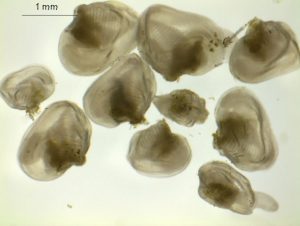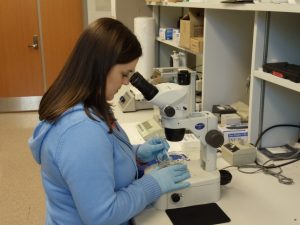Impacts of Rising Stream Temperature on North American Native Freshwater Mussels (Unionidae), MS Research
 Field and laboratory studies have demonstrated that some native mussels are living near their upper thermal limits and that populations may suffer greatly from drought. Before my MS research, laboratory tests of mussel thermal tolerance were conducted by standardized water-only methods, limited to fewer than 10 of North America’s ~300 species, and knowledge of sublethal effects of thermal stress was limited. The goal of my research was to incorporate benthic components – sediment, dewatering, and a vertical thermal gradient – into laboratory thermal trials to better understand mussel thermal ecology in more natural conditions. My objectives were to (1) investigate the effects of sediment on the thermal sensitivity of these benthic organisms by comparing results of tests in water-only vs. sediment; (2) quantify sublethal effects of thermal stress; (3) investigate the combined effects of thermal and dewatering stress; and (4) determine whether subsurface thermal refugia mitigated thermal stress.
Field and laboratory studies have demonstrated that some native mussels are living near their upper thermal limits and that populations may suffer greatly from drought. Before my MS research, laboratory tests of mussel thermal tolerance were conducted by standardized water-only methods, limited to fewer than 10 of North America’s ~300 species, and knowledge of sublethal effects of thermal stress was limited. The goal of my research was to incorporate benthic components – sediment, dewatering, and a vertical thermal gradient – into laboratory thermal trials to better understand mussel thermal ecology in more natural conditions. My objectives were to (1) investigate the effects of sediment on the thermal sensitivity of these benthic organisms by comparing results of tests in water-only vs. sediment; (2) quantify sublethal effects of thermal stress; (3) investigate the combined effects of thermal and dewatering stress; and (4) determine whether subsurface thermal refugia mitigated thermal stress.
 We conducted more than 30 experiments with 6 species of larval and juvenile mussels. We found that, in general, sediment alone did not affect juvenile mussel thermal tolerance, indicating more complex factors likely mitigate thermal stress in the field. Median lethal temperatures in sediment ranged ~ 30 – 37°C. Higher temperatures and dewatering significantly reduced burrowing behavior and byssus (protein-thread) production. Further, mussels did not use available thermal refuge. Our findings suggest that rising stream water temperature and dewatering may directly impact freshwater mussel abundance by causing mortality, and may have indirect impacts via sublethal effects. Reduced burrowing capacity may hamper ability to escape predation or unfavorably high or low flows, and decreased byssus production may inhibit attachment and dispersal capabilities in juveniles. The full results are published in Freshwater Science, Freshwater Biology, and Marine and Freshwater Behaviour and Physiology.
We conducted more than 30 experiments with 6 species of larval and juvenile mussels. We found that, in general, sediment alone did not affect juvenile mussel thermal tolerance, indicating more complex factors likely mitigate thermal stress in the field. Median lethal temperatures in sediment ranged ~ 30 – 37°C. Higher temperatures and dewatering significantly reduced burrowing behavior and byssus (protein-thread) production. Further, mussels did not use available thermal refuge. Our findings suggest that rising stream water temperature and dewatering may directly impact freshwater mussel abundance by causing mortality, and may have indirect impacts via sublethal effects. Reduced burrowing capacity may hamper ability to escape predation or unfavorably high or low flows, and decreased byssus production may inhibit attachment and dispersal capabilities in juveniles. The full results are published in Freshwater Science, Freshwater Biology, and Marine and Freshwater Behaviour and Physiology.